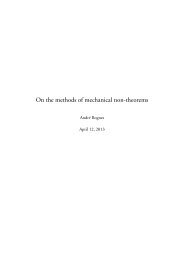The passive voice in written and spoken Scandinavian
The passive voice in written and spoken Scandinavian
The passive voice in written and spoken Scandinavian
Create successful ePaper yourself
Turn your PDF publications into a flip-book with our unique Google optimized e-Paper software.
Sc<strong>and</strong><strong>in</strong>avian <strong>passive</strong> <strong>voice</strong>, as this criterion would exclude the impersonal <strong>passive</strong><br />
constructions (i.e. constructions with <strong>in</strong>transitive verbs). 2<br />
2.1 Two <strong>passive</strong> construction—morphological <strong>and</strong> periphrastic<br />
<strong>The</strong> three Sc<strong>and</strong><strong>in</strong>avian languages have two basic ways of form<strong>in</strong>g the <strong>passive</strong> <strong>voice</strong>:<br />
a morphological <strong>and</strong> a periphrastic. Both of these constructions are, as will be<br />
discussed later, productive, <strong>and</strong> can be used <strong>in</strong> various contexts.<br />
<strong>The</strong> morphological form is constructed by add<strong>in</strong>g the suffix –s (or its variants)<br />
to the verbal stem. 3 <strong>The</strong> verb may be <strong>in</strong>flected for tense. In example (1a–c), a simple<br />
sentence with a morphological <strong>passive</strong> <strong>in</strong> present tense is given <strong>in</strong> Danish (DK),<br />
Norwegian (N) <strong>and</strong> Swedish (S).<br />
(1) (a) Facebook bruges (af mange mennesker) over hele verden. DK<br />
facebook use-S by many people over all world<br />
(b) Facebook brukes (av mange mennesker) over hele verden. N<br />
facebook use-S by many people over all world<br />
(c) Facebook används (av många människor) över hela världen. S<br />
facebook use-S by many people over all world<br />
‘Facebook is used by many people all over the world.’<br />
<strong>The</strong> examples <strong>in</strong>dicate the constructional similarities of the morphological <strong>passive</strong> <strong>in</strong><br />
the three languages. In all of them an s-suffix is added to the verb. An explicit agent<br />
phrase (with the preposition af/av, ‘by’) is, as stated above, not required <strong>and</strong> is<br />
generally omitted.<br />
<strong>The</strong> second option—called the periphrastic <strong>passive</strong>—is constructed by an<br />
auxiliary verb followed by the perfect participle of a ma<strong>in</strong> verb. <strong>The</strong>re are two<br />
auxiliary verbs—blive (DK)/bli (N & S), ‘become’, <strong>and</strong> være (DK & N)/vara (S), ‘be’—<br />
that are used to construct periphrastic <strong>passive</strong>s. In some studies, a few special<br />
constructions with the verb få, ‘get’, followed by the perfect participle are also<br />
treated as a <strong>passive</strong> or <strong>passive</strong>-like construction (Diderichsen 1962, Ryen 1990,<br />
2 For a longer discussion of the notion of demotion <strong>and</strong> the <strong>passive</strong> <strong>voice</strong>, see Sundman (1987) <strong>and</strong><br />
Solstad & Lyngfelt (2006).<br />
3 In the Sc<strong>and</strong><strong>in</strong>avian literature, this form is called the s-<strong>passive</strong>, which will also be used <strong>in</strong> this article.<br />
4

















